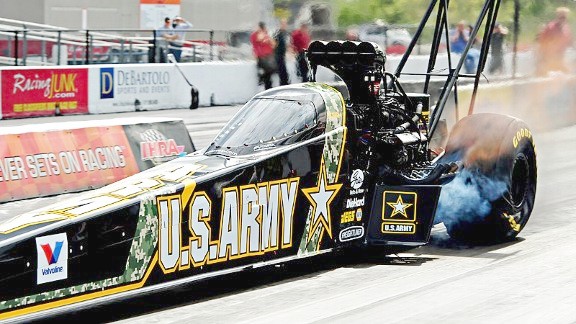Testing proves IndyCar’s idea of a partial canopy won’t work
 |
| Drag Racing at 325 MPH uses full canopies |
James Hinchcliffe doesn't remember what happened for a few hours on May 10 in Indianapolis. From the moment a piece of Justin Wilson's wing hit his helmet during the Indianapolis Grand Prix until he was leaving the hospital later that day, Hinchliffe has no recollection.
"There's nothing that I remember," he told USA TODAY Sports. "I don't recall anything until I was at the hospital getting discharged. The prevailing theory was I was knocked out briefly when it hit me and came to when I ran into Oriol Servia's car. The first thing I started talking about over the radio was wanting to get my helmet off, but I don't remember that."
On the other hand, Antron Brown remembers everything that happened May 16 at Atlanta Dragway. He remembers seeing his car's front wing fly toward him, strike the bulletproof Plexiglas on the canopy of his Top Fuel dragster with a frightening thud and bounce away.
"It wasn't actually that bad initially because I was into the wall, which started to scrub off some speed," Brown told USA TODAY Sports. "But that's when my front wing came off and headed right back at me and hit the canopy. It hit so hard that it buckled it but didn't break it. I was going 315 mph at the time. If the canopy hadn't been there to stop the wing, it would have hit me in the head. I wouldn't be sitting here talking to you today."
 |
| Ferrari F1 car with canopy |
Since Jules Bianchi's horrifying crash Oct. 5 at the Japanese Grand Prix, officials of Formula One and the Verizon IndyCar Series have acknowledged they're looking into derivations of canopies similar to those used by NHRA teams like Brown's. Formula One has done some testing of full enclosures over the cockpits of its cars, while IndyCar's safety committee is discussing the possibility of a partial canopy.
"The first step would be the front half of a canopy, but a complete canopy I don't think is necessary," IndyCar president of operations and competition Derrick Walker told USA TODAY Sports. "Getting out of the car as quickly as possible is the first priority, so a front deflector section seems to be a logical step. … It would be quite an exercise to install as an add-on piece, so it would have to be a part of the chassis design. Since the next generation of Dallara chassis isn't expected for some time, 2018 probably presents the soonest opportunity." [Editor's Note: The following video proves that a full canopy works but Walker's idea of a partial canopy for IndyCar will fail miserably (see 0:51sec mark of video). Just watch the results of both and see how the full canopy performs perfectly.]
In Austin Friday, Formula One drivers remained hopeful of positive news about Bianchi, who remains in critical but stable condition in a hospital in Yokkaichi, Japan, with a severe diffuse axonal injury.
Bianchi's crash, in which his car slid under a large tractor removing another crashed car, drew criticism of F1 safety procedures, Bianchi's team, Marussia F1 Team, and the Suzuka Circuit. It also brought about renewed calls for canopies on F1 cars.
American driver Alexander Rossi, who was set to replace Bianchi in the Russian Grand Prix on Oct. 12 and in Austin before Marussia encountered financial difficulties and parked Rossi's car in Russia and later backed out of the USGP altogether, said he backs any safety decisions made by Federation Internationale de L'Automobile (FIA) in response to Bianchi's crash.
"The FIA has done a fabulous job in addressing safety issues," Rossi told USA TODAY Sports. "I have full faith in the direction they go. I can't really comment directly (on canopies), but I've driven under FIA sanction for years in various series and trust they'll make the right call."
As the NHRA Toyota Nationals get underway this weekend at Las Vegas Motor Speedway, a handful of Top Fuel drivers, including Brown and Don Schumacher Racing teammate Tony Schumacher, are advocating the use of canopy technology on F1 and IndyCar equipment.
"In my career I've hit two birds and something else that I didn't know quite what it was," Schumacher told USA TODAY Sports. "I was lucky in all three cases. A helmet is not meant take a violent hit at the high speeds we run, but with a canopy I'm much safer. If you're going to swing a sledgehammer at me now, I'm going to win every time. I'm inside a much safer car now."
The issues regarding canopies in F1 and IndyCar racing are different than those in drag racing. Visibility, especially in the rain, and the ability to escape, especially if the car is upside down or on fire, are among the first concerns raised by open-wheel drivers. Some, like Hinchcliffe, think a system of deflectors or a partial canopy in front of the cockpit would be more practical, especially in preventing debris from striking drivers.
"As drivers, we're the ones pushing for safety more than anyone," Hinchcliffe said. "My concern is that the right solution hasn't been presented yet. … The biggest concern with a canopy would be getting out of the car after a crash and what happens when it's raining. I'm for anything that helps with safety; I'm just not sure that it doesn't cause more problems than it prevents." [Editor's Note: A canopy ejection system at the push of a button solves the egress problem and as for the rain, is it any worse than it is today with rain hitting your visor and windscreen? Say Rain-X three times fast]
Walker says he favors a partial canopy that would deflect debris but still allow drivers clear visibility and an easier escape. USA Today
